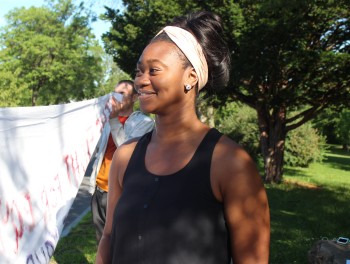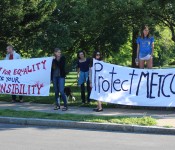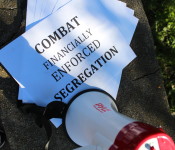Photo: Solar power in Belmont.
Last Tuesday’s meeting of the Municipal Light Board resembled Terminal A at Logan Airport: a place for arrivals and departures all in the same place.
Landing into the contentious debate to create a long-term solar power policy for the town-owned utility Belmont Light, the Light Board (which consists of the members of the Board of Selectmen) announced the formation of a new committee at their meeting held at the Chenery Middle School, on June 15.
Christened with the somewhat unyielding moniker of the “Temporary Net Metering Working Advisory Group” – or TNMWAG for short – the charge of the new three-person body will provide the Board that will be “somewhat independent view” on developing a policy which will “promote solar” in a “responsible” way, according to Light Board chairman Sami Baghdady.
The group, which include three voting members and two alternates “is a balanced group” to accomplish the board’s goals, said Baghdady
While the new group’s arrival was expected – it was negotiated on the floor of Town Meeting earlier in the month – the Light Board’s next move was a sudden, seismic change to the influential Municipal Light Advisory Board as Baghdady announced the board would not reappoint the current chair and vice chair of the influential group when their terms expire at the end of the month.
Chair Ashley Brown and Vice Chair Robert Forrester have each served for more than a decade on the committee. They also have been the leaders of those seeking to limit the size of the tariff that would benefit solar power users, contending that Belmont Light customers
After the meeting, Brown sternly addressed Baghdady after the meeting in a somewhat heated –albeit quiet – conversation centering on why the Light Board had requested both Brown and Forrester submit applications for re-appointment just last month. Brown contended their removal was political in nature, rather than a need to put “new blood” in the MLAB system.
The MLAB departures were in start contrast with the arrival of the appointed group. The body, which will take six-to-eight weeks to review and analyze a new net metering policy, was need as past attempts to structure a framework had created “this massive mistrust” among all factions in the solar power debate in town, Baghdady said.
The three voting members – with two non-voting associates – have heavyweight credentials, starting off with Henry “Jake” Jacoby, the William F. Pounds Professor of Management, Emeritus at MIT Sloan School, a leading expert on national climate policies and the structure of the international climate regime who Baghdady called “a big policy person and someone with a big-picture view” on the subject.
Joining Jacoby in the group will be Stephen Klionsky, an attorney with Northeast Utilities, and an alternate member of the Municipal Light Board Advisory Committee. Klionsky has a law degree from New York University and a Masters in Planning and Public Policy from Harvard.
The final appointed voting member is Roy Epstein, a long-serving member of the town’s Warrant Committee who is an economic consultant (PhD from Yale) and an adjunct professor of Finance at Boston College’s Carroll School of Management .
Attending the meetings as associate members will be Tony Barnes and Robert Gallant.
The appointment of the new members drew a wary eye from the dozen or so solar power proponents sitting in attendance. One solar power supporter questioned the political nature of the selections, pointing to Epstein’s public statements opposing a robust subsidy being advocated by proponents of great solar use in Belmont.
The supporter pondered if Epstein ever took money from oil companies in his employment as an expert witness, unaware Epstein was sitting behind him. The long-time Warrant Committee member took considerable umbrage to the accusation of being a “hired gun” for the petroleum industry.
For the proponents, the new committee will only stall an already delayed policy which, on its face, will affect a small number of users and costing the town – which they contend is overwhelmingly supportive of solar power usage – “pennies.”
“Why such Sturm und Drang” on supporting solar power, asked Claus Becker of Poplar Road.
Light Board member Jim Williams said solar proponents has crafted their proposal evaluated by a research firm for its fairness to non-solar ratepayers. Further delays will only promote uncertainty among solar panel installers that have written off Belmont as a viable community for their work.
“Just do it now,” said Williams, urging his fellow board members to support the solar proponents proposal that focuses on a series of charges, buybacks and tariffs that would subsidize residents use of solar power.
While his two colleagues were willing to make small changes to the existing policy, they did not appear ready to abandon the TNMWAG they just created.




